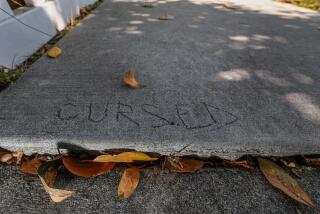Sinkage Report Cites Grouting Problems : Subway: First independent written analysis of Hollywood tunnel project disagrees with MTA officials on several points.
- Share via
Inadequate tunneling procedures--including the failure to grout properly--contributed to sinkage along Hollywood Boulevard in August, according to an engineering analysis prepared for the city of Los Angeles.
The analysis, the first written assessment of the structural problems by engineers not affiliated with the $3-billion subway project, will be presented today to the City Council. A copy of the document was obtained by The Times.
Tunneling beneath Hollywood Boulevard has been shut down since Aug. 18, when surface sinkages of two to nine inches was confirmed along a nine-block area. Federal authorities are investigating, and the Metropolitan Transportation Authority hired a consulting firm Friday to review the construction and related engineering decisions.
Some of the city report’s findings run counter to explanations cited by high-ranking officials of the MTA and by engineers who oversee construction.
For instance, the analysis found that ruptures of water lines along Hollywood Boulevard in August “were the result of the ground settlement caused by the tunneling operations.” Metro Rail engineers and the MTA’s president of construction, Edward McSpedon, have said they were unsure whether the ruptures were caused by the tunneling or by pre-existing factors, such as the Northridge earthquake.
The analysis prepared for the city blamed the sinkages on “time delays” in doing “contact grouting” from within the tunnel. Such grouting is supposed to be done within 16 hours of each advancement of the tunnel-boring machines. The Times reported Sept. 11 that MTA engineers for months did not require the tunneling contractor to do the grouting.
McSpedon, in a Sept. 16 letter to elected officials on the MTA board, said: “Project experience on Hollywood Boulevard and elsewhere has shown that contact grouting has had little significance in reducing surface settlements.” McSpedon could not be reached for comment Monday night.
The city report also found that “several borings” of soil gathered before excavation signaled that the worst-affected area of Hollywood Boulevard contained “running sand conditions” that required special precautions. One soil study in 1990 “states that the running sand . . . may require remedial measures such as chemical grouting from the tunnel face.”
Chemical grouting was not done during tunneling of the area hardest hit by sinkage, roughly from Vine Street to Highland Avenue.
An MTA Tunnel Review Board report, prepared by the project’s chief tunnel designer and distributed Sept. 1, blamed the sinkage in part on ground “which had an indetectable difference in soil consistency . . . compared to other locations along Hollywood Boulevard.”
The city’s report, prepared over the past two weeks by private engineer Gerald D. Lehmer and signed by two city department heads, included other conclusions:
* Wood wedges, used as bracing instead of metal struts, fell far short of the strength required to hold the soil loads. “A substantial number of wood wedges have been crushed and displaced” in tunnels under the north and south sides of Hollywood Boulevard.
* Contact grouting “must be carefully implemented in strict accordance with (project) specifications and warnings” contained in years-old geotechnical reports.
* “Greater reliance should be placed on the (soil) boring data and all geotechnical information in considering preventative measures while tunneling.”
* Additional steel shoring should be installed in the tunnels. The shoring was first erected after the tunnel contractor evacuated workers Aug. 20, fearing that one of the tunnels was in danger of collapse.
* Water is still seeping into the north-side tunnel, between Hudson and Whitley avenues.
More to Read
Sign up for Essential California
The most important California stories and recommendations in your inbox every morning.
You may occasionally receive promotional content from the Los Angeles Times.











